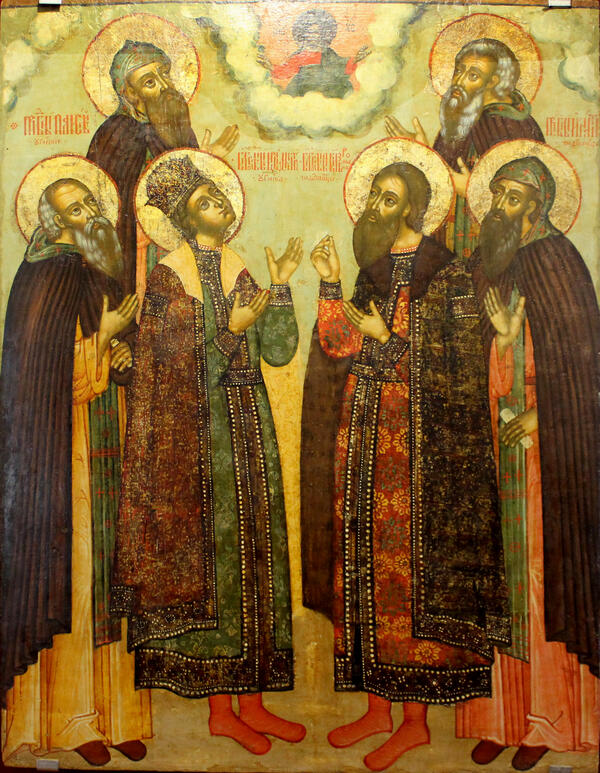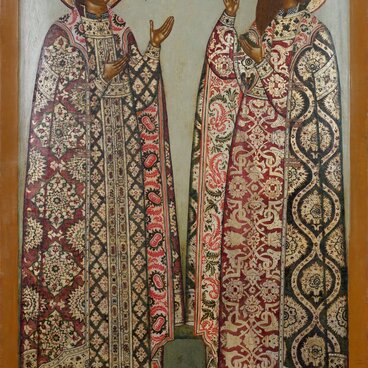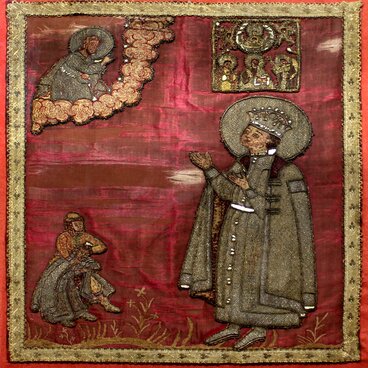After Mikhail Feodorovich Romanov came to power in Moscow, Uglich was given protection by the governing dynasty and soon recovered from the consequences of the Time of Troubles. Five thousand people moved to Uglich, the traditional handicrafts were revived, and the convents and monasteries were restored after being destroyed by the invaders. Throughout the 17th century, Uglich remained the object of attention of noblemen and received generous gifts from the monarchs. Significant monetary donations were regularly received by the city’s monasteries and churches and contributed to its socio-economic and cultural reassertion, while the rich history and culture helped the city overcome the spiritual crisis.
During that period, Uglich icons and embroidered works mostly depicted local saints. One of the icons particularly important for the city was this one depicting the most venerated saints: Saint Paisius of Uglich, Barlaam of Uleima, Tsarevich Dmitry, Prince Roman, Saint Cassian of Uchma, and Ignatius Prilutski. The thin elongated figures are divided into two groups of three saints on each side. Praying for the Uglich land, they stand before the Savior whose half-length image is depicted in the upper area in a cloud. The faces and hands are depicted using the technique of ochering against an olive underpaint. The faces of the saints are thin and spiritual. According to tradition, the icon painter focuses on the figures of two saints, the patrons of Uglich, depicted in the center — Saint Prince Roman and Saint Tsarevich Dmitry. They are dressed in expensive brocade clothes which match their title as princes. The icon was painted using the tempera technique in the early 18th century. The elegant manner of painting, the noble color palette, and the adherence to the 17th-century icon painting traditions helped art experts determine that the icon was painted by some of the leading icon Muscovite artists.
The Moscow school of icon painting developed later than the Novgorod one, and the beginning of its golden age corresponded to the period of strengthening of the Grand Duchy of Moscow (at the turn of the 15th century). Most of the prominent Russian icon painters joined the Moscow school, including Theophanes the Greek, Andrei Rublev, Daniil Chorny, and Dionisius.
During that period, Uglich icons and embroidered works mostly depicted local saints. One of the icons particularly important for the city was this one depicting the most venerated saints: Saint Paisius of Uglich, Barlaam of Uleima, Tsarevich Dmitry, Prince Roman, Saint Cassian of Uchma, and Ignatius Prilutski. The thin elongated figures are divided into two groups of three saints on each side. Praying for the Uglich land, they stand before the Savior whose half-length image is depicted in the upper area in a cloud. The faces and hands are depicted using the technique of ochering against an olive underpaint. The faces of the saints are thin and spiritual. According to tradition, the icon painter focuses on the figures of two saints, the patrons of Uglich, depicted in the center — Saint Prince Roman and Saint Tsarevich Dmitry. They are dressed in expensive brocade clothes which match their title as princes. The icon was painted using the tempera technique in the early 18th century. The elegant manner of painting, the noble color palette, and the adherence to the 17th-century icon painting traditions helped art experts determine that the icon was painted by some of the leading icon Muscovite artists.
The Moscow school of icon painting developed later than the Novgorod one, and the beginning of its golden age corresponded to the period of strengthening of the Grand Duchy of Moscow (at the turn of the 15th century). Most of the prominent Russian icon painters joined the Moscow school, including Theophanes the Greek, Andrei Rublev, Daniil Chorny, and Dionisius.



